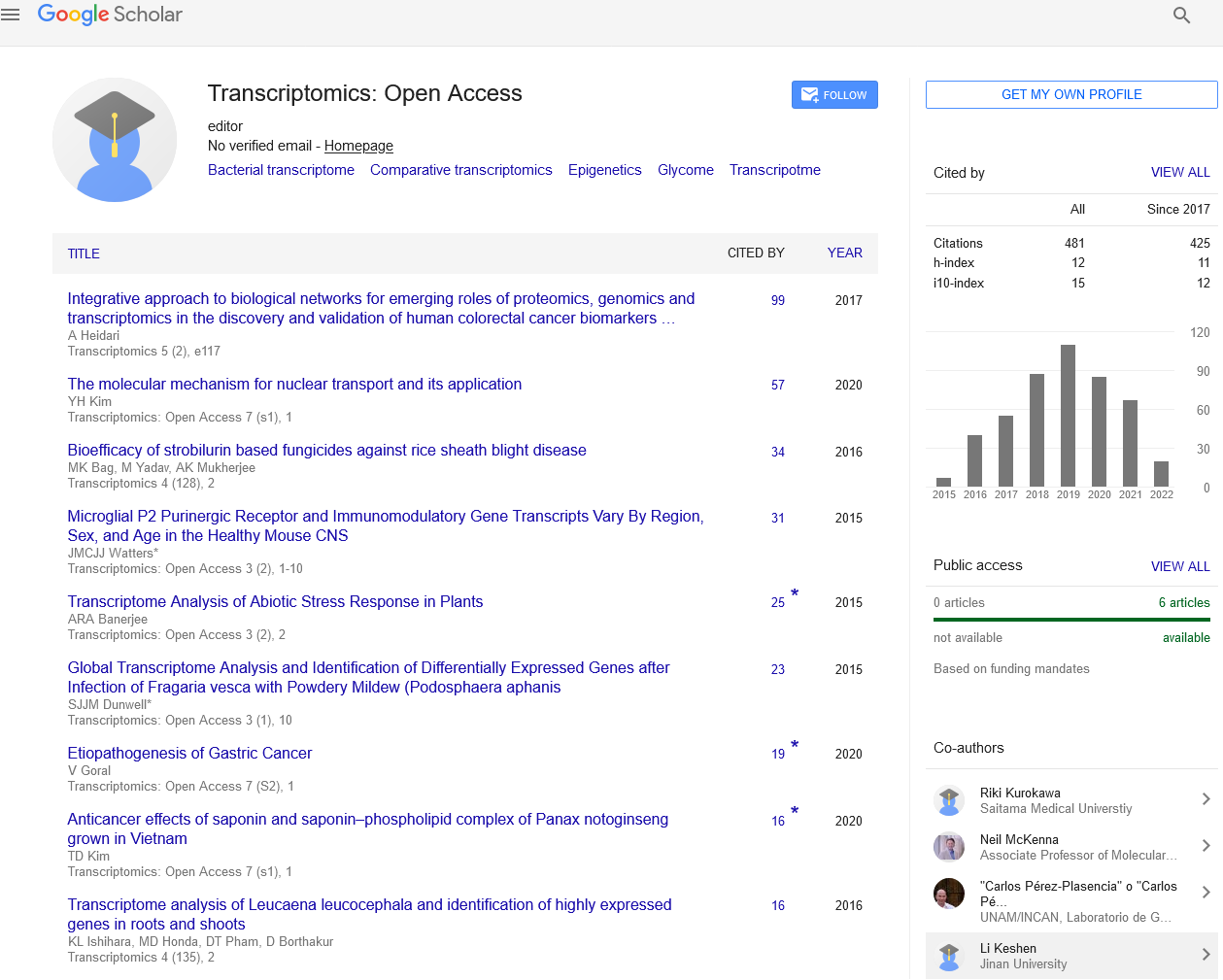Transcriptomics: Open Access : Citations & Metrics Report
Articles published in Transcriptomics: Open Access have been cited by esteemed scholars and scientists all around the world. Transcriptomics: Open Access has got h-index 13, which means every article in Transcriptomics: Open Access has got 13 average citations.
Following are the list of articles that have cited the articles published in Transcriptomics: Open Access.
| 2024 | 2023 | 2022 | 2021 | 2020 | 2019 | 2018 | 2017 | 2016 | 2015 | 2014 | 2013 | |
|---|---|---|---|---|---|---|---|---|---|---|---|---|
Total published articles |
30 | 32 | 30 | 25 | 24 | 0 | 2 | 4 | 14 | 28 | 6 | 6 |
Research, Review articles and Editorials |
0 | 2 | 1 | 10 | 5 | 0 | 1 | 1 | 9 | 17 | 5 | 6 |
Research communications, Review communications, Editorial communications, Case reports and Commentary |
14 | 40 | 30 | 16 | 8 | 0 | 1 | 2 | 5 | 11 | 1 | 0 |
Conference proceedings |
0 | 0 | 0 | 0 | 0 | 0 | 0 | 50 | 52 | 111 | 0 | 0 |
Citations received as per Google Scholar, other indexing platforms and portals |
42 | 58 | 67 | 78 | 96 | 113 | 96 | 67 | 57 | 6 | 2 | 3 |
| Journal total citations count | 552 |
| Journal impact factor | 2.08 |
| Journal 5 years impact factor | 4.98 |
| Journal cite score | 6.92 |
| Journal h-index | 13 |
| Journal h-index since 2019 | 11 |
Important citations (451)
Tag-rnai overcomes off-target effects in cancer models |
|
Hadron spectroscopy, baryon spectroscopy and meson spectroscopy comparative study on malignant and benign human cancer cells and tissues under synchrotron radiation |
|
Hadron spectroscopy, baryon spectroscopy and meson spectroscopy comparative study on malignant and benign human cancer cells and tissues under synchrotron radiation |
|
Human malignant and benign human cancer cells and tissues biospectroscopic analysis under synchrotron radiation using anti-cancer nano drugs delivery |
|
A hypertension approach to thermal infrared spectroscopy and photothermal infrared spectroscopy comparative study on malignant and benign human cancer cells and tissues under synchrotron radiation with the passage of time |
|
Investigation of energy production by synchrotron, synchrocyclotron and laser radiations in human cancer cells, tissues and tumors and evaluation of their effective on human cancer cells, tissues and tumors treatment trend |
|
High–resolution mapping of dna/rna hypermethylation and hypomethylation process in human cancer cells, tissues and tumors under synchrotron radiation |
|
Replication study: melanoma exosomes educate bone marrow progenitor cells toward a pro-metastatic phenotype through met |
|
Assessing the variety of synchrotron, synchrocyclotron and laser radiations and their roles and applications in human cancer cells, tissues and tumors diagnosis and treatment |
|
Evaluating the effect of anti–cancer nano drugs dosage and reduced leukemia and polycythemia vera levels on trend of the human blood and bone marrow cancers under synchrotron radiation |
|
Pros and cons controversy on malignant human cancer cells, tissues and tumors transformation process to benign human cancer cells, tissues and tumors |
|
Vibrational biospectroscopic study and chemical structure analysis of unsaturated polyamides nanoparticles as anti–cancer polymeric nanomedicines using synchrotron radiation |
|
The science of puromycin: from studies of ribosome function to applications in biotechnology |
|
Uranocene (u(c8h8)2) and bis(cyclooctatetraene)iron (fe(c8h8)2 or fe(cot)2)–enhanced precatalyst preparation stabilization and initiation (eppsi) nano molecules |
|
Angelic acid, diabolic acids, draculin and miraculin nano molecules incorporation into the nano polymeric matrix (npm) by immersion of the nano polymeric modified electrode (npme) as molecular enzymes |
|
Three–dimensional (3d) simulations of human cancer cells, tissues and tumors for using in human cancer cells, tissues and tumors diagnosis and treatment as a powerful tool in human cancer cells, tissues and tumors research and anti–cancer nano drugs sensitivity and delivery area discovery and evaluation |
|
Heteronuclear single–quantum correlation spectroscopy (hsqc) and heteronuclear multiple– bond correlation spectroscopy (hmbc) comparative study on malignant and benign human cancer cells and tissues with the passage of time under synchrotron radiation |
|
The effect of temperature on cadmium oxide (cdo) nanoparticles produced by synchrotron radiation in the human cancer cells, tissues and tumors |
|
Palauamine and olympiadane nano molecules incorporation into the nano polymeric matrix (npm) by immersion of the nano polymeric modified electrode (npme) as molecular enzymes and drug targets for human cancer cells, tissues and tumors treatment under synchrotron and synchrocyclotron radiations |
|
A review on separation techniques of graphene oxide (go)/ base on hybrid polymer membranes for eradication of dyes and oil compounds: recent progress in graphene oxide (go)/ base on polymer membranes-related nanotechnologies |
|
